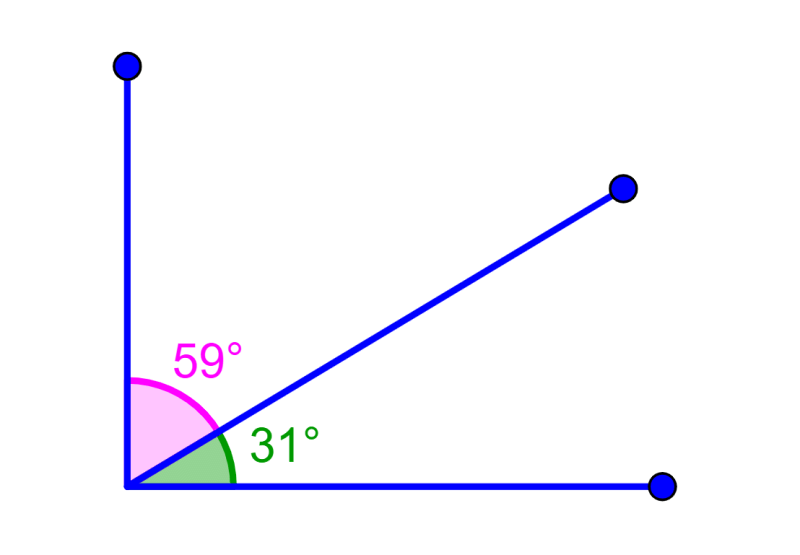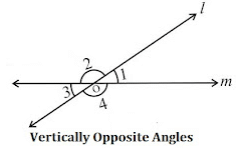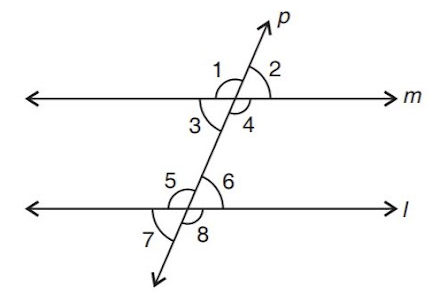Class 7 Exam > Class 7 Notes > Mathematics Olympiad Class 7 > Summary: Lines & Angles
Lines & Angles Summary Class 7 NCERT Summary Chapter 1
Recall
- A Point means a location.
- A line is a straight that extends endlessly in both directions.

- A line segment is the part of a line between two points.

- A ray is part of a line that starts at one point and extends endlessly in another direction.

- An angle is formed when lines or line segments meet.

Related Angles
- When the sum of the measures of two angles is 90°, the angles are called complementary angles.
- Whenever two angles are complementary, each angle is said to be the complement of the other angle.
 Complementary Angles
Complementary Angles
- When the sum of the measures of two angles is 180°, the angles are called Supplementary angles.
- When two angles are supplementary, each angle is said to be the supplement of the other.
 Supplementary Angles
Supplementary Angles
- Two angles with a common vertex and common arm but no common interior points are called Adjacent angles.
- These angles are such that:
(i) they have a common vertex;
(ii) they have a common arm; and
(iii) the non-common arms are on either side of the common arm. - A linear pair is a pair of adjacent angles whose non-common sides are opposite rays.
- Vertically Opposite Angles: Two angles formed by two intersecting lines having no common arm. When two lines intersect, the vertically opposite angles so formed are equal.

Pair of Lines
- Intersecting Lines: Two or more lines that have one and only one point in common. The common point where all the intersecting lines meet is called the point of intersection.
- A line that intersects two or more lines at distinct points is called a transversal.
- Parallel lines: Two lines in the same plane that are at equal distance from each other and never meet.
- Alternate interior angle : The pair of angles on opposite sides of the transversal but inside the two lines are called alternate interior angles.
- Alternate exterior angle : The pair of angles on the opposite sides of the transversal but outside the two lines are called alternate exterior angles
- When two lines are intersected by a transversal, eight angles are formed.

Interior angles: ∠3, ∠4, ∠5, ∠6
Exterior angles: ∠1, ∠2, ∠7, ∠8
Pairs of corresponding angles: ∠1 and ∠5, ∠2 and ∠6, ∠3 and ∠7, ∠4 and ∠8
Pairs of Alternate interior angles: ∠3 and ∠6, ∠4 and ∠5
Pairs of Alternate exterior angles: ∠1 and ∠8, ∠2 and ∠7
Pairs of interior angles on the same side of the transversal: ∠3 and ∠5, ∠4 and ∠6.
Transversal of parallel lines
If two parallel lines are intersected by a transversal, each pair of:
- corresponding angles are congruent
- alternate interior angles are congruent
- alternate exterior angles are congruent
- interior angles on the same side of the transversal are supplementary.
The document Lines & Angles Summary Class 7 NCERT Summary Chapter 1 is a part of the Class 7 Course Mathematics Olympiad Class 7.
All you need of Class 7 at this link: Class 7
|
40 videos|118 docs|99 tests
|
FAQs on Lines & Angles Summary Class 7 NCERT Summary Chapter 1
| 1. What are lines and angles in mathematics? |  |
Ans. In mathematics, lines are straight paths that extend infinitely in both directions, while angles are the measure of the space between two intersecting lines or rays. Lines can be vertical, horizontal, diagonal, or curved, whereas angles can be acute, obtuse, right, straight, or reflex.
| 2. How do you classify angles based on their measures? |  |
Ans. Angles can be classified based on their measures as follows:
- Acute angles: Measures between 0 and 90 degrees.
- Obtuse angles: Measures between 90 and 180 degrees.
- Right angles: Measures exactly 90 degrees.
- Straight angles: Measures exactly 180 degrees.
- Reflex angles: Measures between 180 and 360 degrees.
| 3. What is the sum of the angles of a triangle? |  |
Ans. The sum of the angles of any triangle is always 180 degrees. This property holds true for all types of triangles, whether they are equilateral, isosceles, or scalene.
| 4. How can you determine if two lines are parallel? |  |
Ans. Two lines are considered parallel if they never intersect, meaning they do not share any common points. One way to determine if two lines are parallel is by examining their slopes. If the slopes of the two lines are equal, then they are parallel. Another way is to observe if the corresponding angles formed by a transversal intersecting the lines are congruent.
| 5. Can a triangle have two right angles? |  |
Ans. No, a triangle cannot have two right angles. The sum of the angles of a triangle is 180 degrees, and if two of the angles are right angles (each measuring 90 degrees), then the third angle would have to be 0 degrees, which is not possible in a triangle.
Related Searches
















